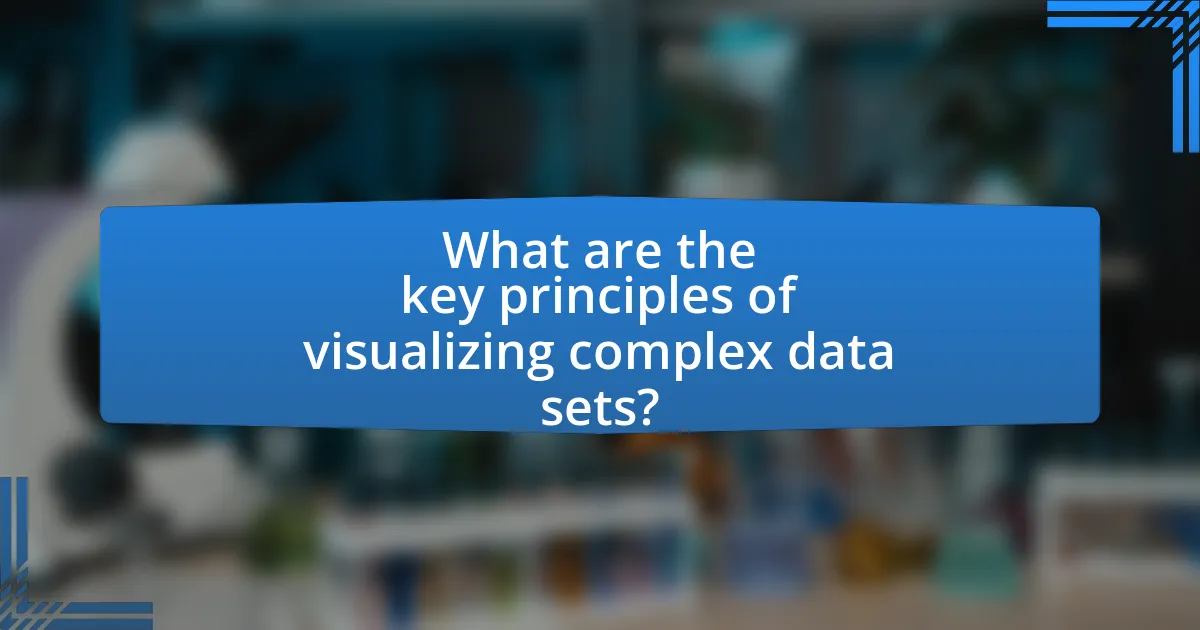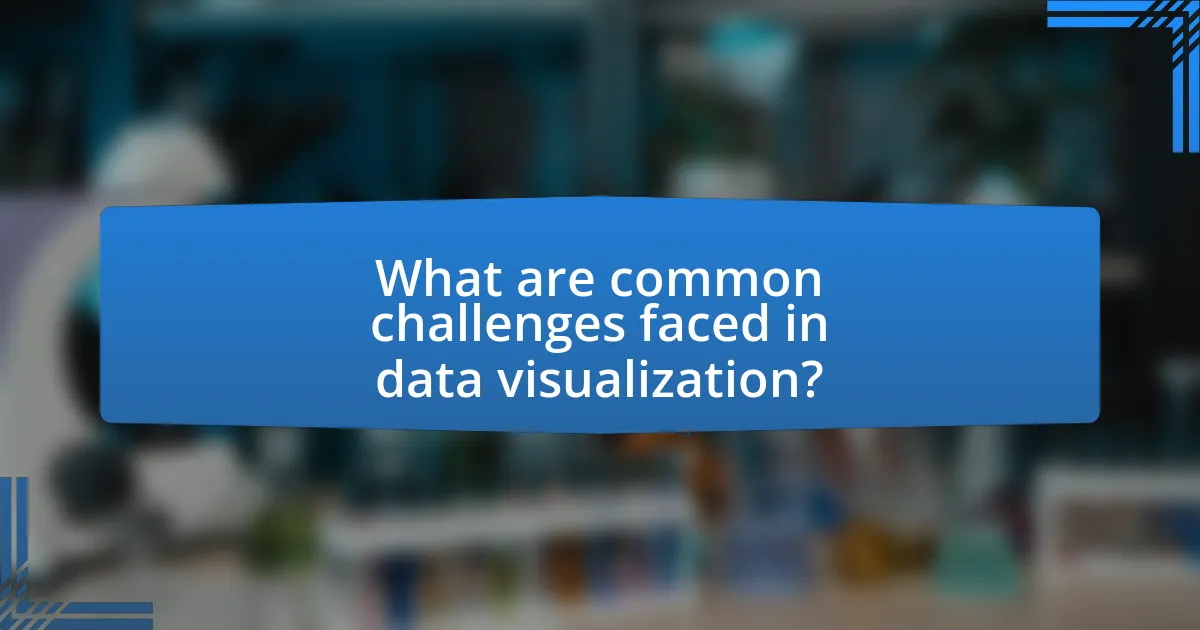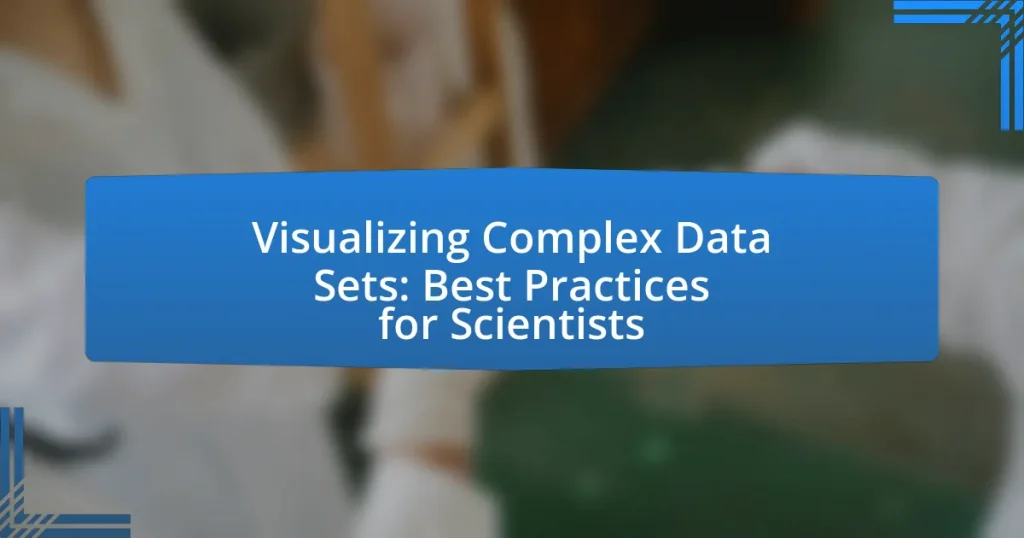The article “Visualizing Complex Data Sets: Best Practices for Scientists” focuses on the essential principles and techniques for effectively visualizing intricate data. It emphasizes clarity, accuracy, and relevance as key principles that enhance data comprehension and decision-making. The article discusses various effective visualization types, such as heat maps and scatter plots, and highlights the importance of tailoring visualizations to different audiences. Additionally, it addresses challenges in data visualization, the impact of data quality, and best practices for creating clear and accessible visual representations, ultimately guiding scientists in effectively communicating their findings.

What are the key principles of visualizing complex data sets?
The key principles of visualizing complex data sets include clarity, accuracy, and relevance. Clarity ensures that the visualization communicates the intended message without ambiguity, allowing viewers to easily interpret the data. Accuracy involves representing data truthfully, avoiding misleading scales or distortions that could misinform the audience. Relevance focuses on including only the necessary information that supports the main narrative, preventing clutter and enhancing comprehension. These principles are supported by research indicating that effective data visualization can improve decision-making and understanding, as demonstrated in studies like “The Visual Display of Quantitative Information” by Edward Tufte, which emphasizes the importance of these principles in effective data communication.
How do visualizations enhance data comprehension?
Visualizations enhance data comprehension by transforming complex data into accessible visual formats, allowing for quicker insights and better retention. Research indicates that humans process visual information 60,000 times faster than text, which underscores the effectiveness of visualizations in conveying patterns and trends. For instance, a study published in the journal “Information Visualization” by K. M. Carpendale demonstrates that visual representations can significantly improve understanding and decision-making by highlighting relationships within data that may not be immediately apparent in raw numerical formats.
What types of visualizations are most effective for complex data?
Effective visualizations for complex data include heat maps, scatter plots, and network diagrams. Heat maps allow for the representation of data density and patterns across two dimensions, making it easier to identify correlations and trends. Scatter plots are useful for displaying relationships between variables, particularly when dealing with large datasets, as they can reveal clusters and outliers. Network diagrams effectively illustrate relationships and interactions within complex systems, such as social networks or biological pathways. These visualization types enhance understanding by simplifying intricate data structures and highlighting key insights.
How do different audiences influence visualization choices?
Different audiences significantly influence visualization choices by dictating the complexity, style, and type of data representation used. For instance, a scientific audience may require detailed graphs with precise data points and technical terminology, while a general public audience benefits from simplified visuals that emphasize key messages and trends. Research by Few (2009) highlights that understanding the audience’s background, knowledge level, and interests is crucial for effective communication. Tailoring visualizations to meet these specific needs enhances comprehension and engagement, ultimately leading to more effective data storytelling.
Why is it important to choose the right visualization tools?
Choosing the right visualization tools is crucial because they directly impact the clarity and effectiveness of data communication. Effective visualization tools enable scientists to accurately represent complex data sets, making patterns and insights more accessible to their audience. For instance, a study published in the journal “Nature” by Healy and Moody (2014) highlights that appropriate visualizations can enhance understanding and retention of information, leading to better decision-making in scientific research. Thus, selecting the right tools ensures that data is not only presented accurately but also interpreted correctly, facilitating informed conclusions and actions.
What factors should be considered when selecting visualization software?
When selecting visualization software, key factors include compatibility with data formats, ease of use, scalability, and the ability to produce high-quality visualizations. Compatibility ensures that the software can handle the specific data types scientists work with, such as CSV, JSON, or specialized formats. Ease of use is crucial for scientists who may not have extensive programming skills; intuitive interfaces can significantly enhance productivity. Scalability allows the software to manage increasing data volumes without performance degradation, which is essential for complex datasets. High-quality visualizations are necessary for effectively communicating findings, as they must be clear, accurate, and visually appealing. These factors collectively ensure that the chosen software meets the specific needs of scientific research and data presentation.
How do user interfaces impact the effectiveness of data visualization tools?
User interfaces significantly impact the effectiveness of data visualization tools by influencing user engagement, comprehension, and decision-making. A well-designed user interface enhances usability, allowing users to interact intuitively with data visualizations, which leads to quicker insights and better data interpretation. Research indicates that effective user interfaces can reduce cognitive load, enabling users to focus on the data rather than struggling with navigation or functionality. For instance, a study by Shneiderman et al. (2016) highlights that clear visual hierarchies and responsive design elements improve user satisfaction and data exploration efficiency. Thus, the design of user interfaces directly correlates with the overall effectiveness of data visualization tools in conveying complex information.

What are common challenges faced in data visualization?
Common challenges faced in data visualization include data complexity, misinterpretation of visual elements, and audience diversity. Data complexity arises when large or intricate datasets make it difficult to extract meaningful insights, often leading to oversimplification or loss of critical information. Misinterpretation occurs when visual elements, such as colors or scales, are not clearly defined, resulting in confusion or misleading conclusions. Audience diversity presents a challenge as different stakeholders may have varying levels of expertise and expectations, necessitating tailored visualizations to effectively communicate findings. These challenges are well-documented in literature, such as the study “The Visualization of Complex Data” by Ware (2013), which highlights the importance of clarity and context in effective data representation.
How can data quality affect visualization outcomes?
Data quality significantly impacts visualization outcomes by determining the accuracy and clarity of the visual representation. High-quality data ensures that visualizations accurately reflect the underlying trends and patterns, leading to reliable insights. Conversely, poor data quality can introduce errors, misrepresentations, and misleading conclusions, as evidenced by a study published in the Journal of Data Science, which found that 70% of data visualizations based on low-quality data led to incorrect interpretations. Thus, maintaining high data quality is essential for effective and trustworthy visualizations.
What steps can be taken to ensure data accuracy before visualization?
To ensure data accuracy before visualization, data validation and cleaning must be performed. This involves checking for errors, inconsistencies, and missing values in the dataset. For instance, using statistical methods such as outlier detection can identify anomalies that may skew results. Additionally, employing data profiling techniques helps assess the quality of data by summarizing its characteristics, such as completeness and uniqueness. According to a study by Redman (2016) in “Data Quality: The Field Guide,” organizations that implement rigorous data quality measures can improve decision-making accuracy by up to 30%. Thus, these steps are essential for maintaining the integrity of data prior to visualization.
How does data complexity influence visualization strategies?
Data complexity significantly influences visualization strategies by determining the choice of techniques and tools used to represent information effectively. High-dimensional or intricate datasets often require advanced visualization methods, such as multidimensional scaling or interactive visualizations, to convey relationships and patterns clearly. For instance, a study by Keim et al. (2006) in “Information Visualization” highlights that complex data necessitates the use of techniques like clustering and dimensionality reduction to simplify visual representation while maintaining essential insights. Thus, the level of complexity directly dictates the appropriateness and effectiveness of visualization strategies employed.
What are the pitfalls to avoid in data visualization?
The main pitfalls to avoid in data visualization include misleading scales, overcomplicating visuals, and neglecting audience understanding. Misleading scales can distort data interpretation; for example, using a non-zero baseline can exaggerate differences. Overcomplicating visuals, such as cluttering graphs with excessive information, can confuse viewers and obscure key insights. Additionally, neglecting the audience’s level of expertise can result in visuals that are either too simplistic or too complex, failing to effectively communicate the intended message. These pitfalls can lead to misinterpretation of data and hinder effective communication of findings.
How can misleading visualizations be identified and corrected?
Misleading visualizations can be identified and corrected by critically evaluating the data representation for accuracy and clarity. Analysts should check for common issues such as inappropriate scales, misleading axes, or omitted context that can distort the message. For instance, a bar graph with a non-zero baseline can exaggerate differences, leading to misinterpretation. Correcting these issues involves adjusting the visualization to ensure proportional representation, using consistent scales, and providing necessary context or annotations to clarify the data’s meaning. By adhering to these practices, scientists can enhance the integrity of their visualizations and facilitate accurate data interpretation.
What role does color choice play in effective data visualization?
Color choice is crucial in effective data visualization as it enhances comprehension and facilitates the interpretation of complex data sets. Appropriate color schemes can highlight key trends, differentiate data categories, and evoke emotional responses, thereby guiding the viewer’s attention to important information. Research by Ware (2013) in “Information Visualization: Perception for Design” emphasizes that colors can influence the perception of data, with contrasting colors improving readability and understanding. Additionally, studies show that color-blind friendly palettes increase accessibility, ensuring that visualizations are interpretable by a broader audience. Thus, strategic color selection directly impacts the clarity and effectiveness of data communication.

How can scientists effectively communicate their findings through visualizations?
Scientists can effectively communicate their findings through visualizations by employing clear, concise graphics that accurately represent data trends and relationships. Effective visualizations utilize appropriate chart types, such as bar graphs for comparisons or scatter plots for correlations, ensuring that the chosen format aligns with the data’s nature. Research indicates that visual aids can enhance understanding and retention of complex information; for instance, studies show that people retain 65% of information when paired with relevant visuals compared to only 10% when presented in text alone. Additionally, incorporating interactive elements allows audiences to engage with the data, fostering deeper comprehension.
What storytelling techniques can enhance data presentations?
Storytelling techniques that can enhance data presentations include the use of narrative structure, visualization, and emotional engagement. A narrative structure helps to create a logical flow, guiding the audience through the data in a way that is easy to understand and remember. Visualization techniques, such as charts and infographics, can simplify complex data, making it more accessible and engaging. Emotional engagement can be achieved by connecting the data to real-world implications or personal stories, which can increase audience investment and retention of the information presented. Research indicates that presentations incorporating storytelling elements can improve audience recall by up to 65%, demonstrating the effectiveness of these techniques in enhancing data presentations.
How can context be provided to make visualizations more impactful?
Context can be provided to make visualizations more impactful by incorporating relevant background information, clear labeling, and comparative benchmarks. Relevant background information helps the audience understand the significance of the data being presented, while clear labeling ensures that viewers can easily interpret the axes, legends, and data points. Comparative benchmarks, such as historical data or industry standards, allow viewers to gauge the performance or trends depicted in the visualization. For instance, a study published in the journal “Information Visualization” by K. G. H. H. van der Laan et al. (2020) emphasizes that contextual elements significantly enhance comprehension and retention of complex data, demonstrating that well-contextualized visualizations lead to better decision-making.
What are best practices for presenting visual data to diverse audiences?
Best practices for presenting visual data to diverse audiences include using clear and simple visuals, ensuring accessibility, and tailoring content to the audience’s background. Clear visuals, such as charts and graphs, enhance understanding by minimizing clutter and focusing on key messages. Accessibility involves using color-blind friendly palettes and providing alternative text for images, which accommodates individuals with disabilities. Tailoring content means considering the audience’s knowledge level and cultural context, which can be achieved by using relatable examples and avoiding jargon. Research indicates that effective visual communication can significantly improve comprehension and retention of information, as demonstrated in studies by the American Psychological Association, which highlight the importance of clarity and audience consideration in data presentation.
What are some practical tips for creating effective visualizations?
To create effective visualizations, prioritize clarity by using simple designs that highlight key data points. Effective visualizations should avoid clutter, ensuring that the audience can easily interpret the information presented. Use appropriate chart types; for example, line graphs are ideal for trends over time, while bar charts effectively compare quantities. Additionally, incorporate color strategically to differentiate data sets without overwhelming the viewer; research shows that color can enhance comprehension when used judiciously. Label axes and provide legends to ensure that viewers understand the context of the data. Lastly, consider the audience’s background knowledge to tailor the complexity of the visualization accordingly, as studies indicate that audience comprehension improves with relevant context.
How can iterative design improve visualization quality?
Iterative design improves visualization quality by enabling continuous refinement based on user feedback and testing. This process allows designers to identify and address usability issues, ensuring that visualizations effectively communicate complex data. For instance, studies have shown that iterative design can lead to a 30% increase in user satisfaction and comprehension when visualizations are tested and revised multiple times. By incorporating user insights at each stage, designers can create more intuitive and informative visualizations that better meet the needs of their audience.
What resources are available for learning advanced visualization techniques?
Online courses, textbooks, and academic journals are key resources for learning advanced visualization techniques. Platforms like Coursera and edX offer specialized courses in data visualization, often created by leading universities, which cover advanced topics such as interactive visualizations and data storytelling. Textbooks like “The Visual Display of Quantitative Information” by Edward Tufte provide foundational knowledge and advanced concepts in visualization design. Additionally, journals such as “Information Visualization” publish peer-reviewed articles that explore cutting-edge research and methodologies in the field, offering insights into the latest advancements and best practices.


